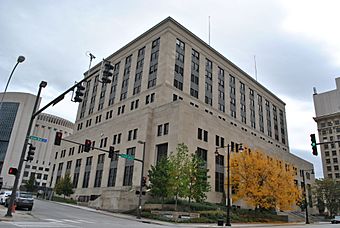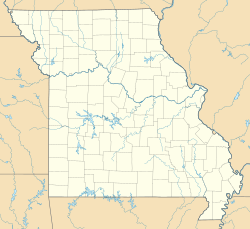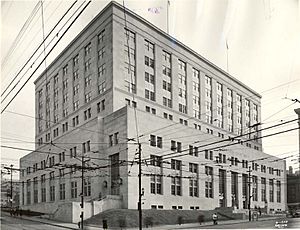United States Courthouse and Post Office (Kansas City, Missouri) facts for kids
Quick facts for kids |
|
|
U.S. Courthouse and Post Office-Kansas City, MO
|
|

U.S. Courthouse and Post Office
|
|
| Location | 811 Grand Blvd., Kansas City, Missouri |
|---|---|
| Area | 1.7 acres (0.69 ha) |
| Architect | Wight & Wight |
| Architectural style | Moderne |
| NRHP reference No. | 07001231 |
| Added to NRHP | November 20, 2007 |
The United States Courthouse and Post Office in Kansas City, Missouri is a very important historic building. It used to be a place where federal (national) court cases were heard and where people sent mail. It's also known as the Federal Courts Building.
Contents
History of the Building
In the early 1900s, Kansas City grew very quickly. By 1930, the city needed a bigger building for its federal offices. The old post office and customs house were too small.
During the 1930s, the United States was in a tough time called the Great Depression. Many people did not have jobs. The government started programs called the New Deal to help. These programs funded new buildings across the country to create jobs. In 1935, the New Deal helped pay for this new U.S. Post Office and Courthouse in Kansas City.
Construction of the building happened from 1938 to 1939. It was one of the last big projects of the New Deal. The building provided modern space for the growing federal government in Kansas City.
Who Designed It?
A famous local architecture firm, Wight and Wight, designed the building. They also designed other important buildings in Kansas City, like the Jackson County Courthouse and City Hall.
Wight and Wight started to use a new style called Moderne. This style was becoming popular in the 1930s. The Courthouse shows this change, mixing older classical ideas with new Art Deco touches.
Important Events at the Courthouse
In 1952, the building became famous for a special reason. A lawyer named Thurgood Marshall argued a case there about desegregating (ending separation by race) the Swope Park Swimming Pool. This was a very important moment for the Civil Rights Movement in Kansas City. Thurgood Marshall later became a Supreme Court Justice.
The U.S. Post Office and Courthouse was added to the National Register of Historic Places in 2003. This means it is a very important historical site.
Building Design and Style
The U.S. Post Office and Courthouse is a great example of the Art Moderne style. This style was popular in the late 1930s. Architects used simple shapes and less decoration.
The building is made of Indiana limestone. It has smooth, flat walls with very little fancy design. It takes up a whole city block along Grand Avenue.
Outside the Building
The building is ten stories tall. Each of its four sides looks similar. The bottom three stories have smooth walls with tall windows. Wide granite steps lead up to the main entrances on Grand Avenue. The dark bronze around the doors looks nice against the light gray limestone walls.
The upper stories are set back a bit from the base. They continue with the same smooth limestone walls. There's a decorative line of Greek patterns above the fourth story. The windows on the upper floors are also tall and simple.
Inside the Building
The inside of the building is also very elegant and simple. It uses beautiful materials and geometric patterns. The entrance area has marble walls and a black granite base. It has original bronze details and phone booths.
The main lobby is shaped like a "T". It has colorful terrazzo floors, which are made of polished stone chips. The walls are made of golden-veined marble. The ceiling is high and has geometric patterns. Large marble columns stand in the middle of the lobby.
The old postal lobby also has fancy materials like marble and terrazzo floors.
Courtrooms
There are four historic courtrooms on the fourth and sixth floors. These rooms are very important because they still look like they did when they were built. They are two stories tall and have leather-covered doors. They have cork-tile floors, pink-granite baseboards, and wood-paneled walls.
The ceilings have special panels with original brass lights. The courtrooms do not have windows. Instead, they used advanced lighting and air conditioning. This was very modern when the building was finished.
Quick Facts About the Building
- Architect: Wight & Wight
- Built: 1938-1939
- Location: 811 Grand Blvd.
- Style: Art Moderne
- Main Materials: Indiana Limestone over steel and concrete
- Special Features: Bronze decorations outside; historic courtrooms




